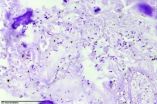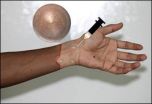(Press-News.org) CHAMPAIGN, Ill. — Haste makes waste, as the old saying goes. And according to research from a University of Illinois expert in patent law, the same adage could be applied to the U.S. Patent and Trademark Office, where high-ranking examiners have a tendency to rubber-stamp patents of questionable merit due to time constraints.
The less time patent examiners are given to review an application, the more likely they are to grant patent protection to inventions "on the margin," says a study co-authored by Melissa Wasserman, the Richard and Anne Stockton Faculty Scholar and Richard W. and Marie L. Corman Scholar at the College of Law.
"Patent quality is at the heart of patent reform debate," Wasserman said. "It is generally agreed that the patent office is allowing too many invalid patents, which is bad for society for a number of reasons, including that these patents may actually impede rather than promote innovation. Congress and the courts have recognized this, and have been trying to tweak the patent system in an effort to increase patent quality. Essentially, they've been trying to help the patent office do a better job.
"But until now, there's been very little compelling empirical evidence that any particular feature of the patent office has been causing them to over-grant and thereby allow invalid patents."
With the help of the National Center for Supercomputing Applications, Wasserman and co-author Michael D. Frakes of the Northwestern University School of Law performed a data analysis on 1.4 million patent applications considered by the office from 2002 to 2012. They cross-referenced their analysis with examiner roster data obtained through a series of Freedom of Information Act requests from the U.S. Patent and Trademark Office.
"For a lot of the information we gathered, the only source is the patent and trademark office, which has become a lot more open to researchers and academics in recent years," Wasserman said.
The researchers found that an examiner's promotion to each subsequent step-up in pay equated to a 10- to 15-percent decrease in the number of hours allocated to review a patent application. Examiners operating at the highest level were expected to review an application in about half the time allocated to examiners at the lowest level, according to the paper.
Under the assumption that patent examiners who are given sufficient time to review applications will, on average, make the correct patentability determinations, the results suggest that the time allotments are inducing higher ranked patent examiners to grant invalid patents, the researchers say.
"Our findings suggest that the process of promoting patent examiners, which is meant to reward admirable behavior on the part of examiners, may, in part, be responsible for the agency issuing patents of marginal quality," Wasserman said. "It also sheds some light on the widely held belief that decreasing patent examiner attrition or intensifying the monitoring of newly hired examiners is vital to increasing patent quality."
According to the paper, as an examiner is given less time to review an application, they become less inclined to search for prior art, which, in turn, makes it less likely that the examiner makes a prior art-based rejection. In particular, "obviousness" rejections, which are especially time-intensive, decrease, Wasserman said.
"Our findings provide empirical evidence for policymakers to utilize to increase patent quality," she said. "That is, we find how the patent office decreases the time allocated to review applications as patent examiners are promoted may be partially responsible for the agency granting too many invalid patents. If patent examiners are already pressed for time and the time allocated to review an application is further decreased, it is likely that examiners will spend less time searching the prior art, and that's going to make it harder for them to figure out which patents are really new, and which ones represent just a trivial advancement over current scientific understanding.
"And this is how they're going to end up granting more. They're just not given enough time to look through everything that has already been created and invented to determine whether or not the claimed invention is really new or non-obvious."
Wasserman, whose research focuses on the institutional design of innovation policy, with a particular emphasis on patent law and administrative law, said not having enough time is the common denominator.
"In general, I think the office is right: As you get better at your job, you will likely be able to do it faster," she said. "It's just that our results suggest that the scaling of time allocations may be too aggressive. There may be just some set amount of time that's needed to search the prior art, and once you decrease time allocations below this number, patent examiners are not going to be able to do a good job, no matter how good of an examiner they are."
The research has implications for "patent assertion entities," otherwise known (and pejoratively referred to) in the media as "patent trolls," Wasserman said.
"To the extent so-called patent trolls are asserting invalid patents, our results suggest one reason as to why the office is issuing these marginal patents," she said.
The research also points to another potentially troubling conclusion: Similar patent applications are sometimes treated in dissimilar ways.
"In an ideal world, a patent should be granted or rejected solely on the merits of the application," Wasserman said. "But it turns out that the decision to allow a patent may be more happenstance based on which examiner gets assigned your application. If you have two individuals, you and a competitor, and your competitor gets assigned a high-ranked examiner, and you get a low-ranked examiner, it's more likely that your competitor is going to get their patent approved than you, which creates an unfair advantage."
INFORMATION:
Editor's note: To contact Melissa Wasserman, call 217-244-3960; email mfwasser@illinois.edu.
The paper, "Is the Time Allocated to Review Patent Applications Inducing Examiners To Grant Invalid Patents?: Evidence From Micro-Level Application Data," is available online.
Patent examiners more likely to approve marginal inventions when pressed for time
2014-08-13
ELSE PRESS RELEASES FROM THIS DATE:
Bones from nearly 50 ancient flying reptiles discovered
2014-08-13
Scientists discovered the bones of nearly 50 winged reptiles from a new species, Caiuajara dobruskii, that lived during the Cretaceous in southern Brazil, according to a study published August 13, 2014 in the open-access journal PLOS ONE by Paulo Manzig from Universidade do Contestado, Brazil, and colleagues.
The authors discovered the bones in a pterosaur bone bed in rocks from the Cretaceous period. They belonged to individuals ranging from young to adult, with wing spans ranging from 0.65-2.35m, allowing scientists to analyze how the bones fit into their clade, but ...
Embalming study 'rewrites' chapter in Egyptian history
2014-08-13
The origins of mummification may have started in ancient Egypt 1,500 years earlier than previously thought, according to a study published August 13, 2014 in the open-access journal PLOS ONE by Stephen Buckley from University of York and colleagues from Macquarie University and University of Oxford.
Previous evidence suggests that between ~4500 B.C. and 3100 B.C., Egyptian mummification consisted of bodies desiccating naturally through the action of the hot, dry desert sand. The early use of resins in artificial mummification has, until now, been limited to isolated occurrences ...
Little penguins forage together
2014-08-13
Most little penguins may search for food in groups, and even synchronize their movements during foraging trips, according to a study published August 13, 2014 in the open-access journal PLOS ONE by Maud Berlincourt and John Arnould from Deakin University in Australia.
Little penguins are the smallest penguin species and they live exclusively in southern Australia, New Zealand, and the Chatham Islands, but spend most of their lives at sea in search of food. Not much is known about group foraging behavior in seabirds due to the difficulty in observing their remote feeding ...
Young blue sharks use central North Atlantic nursery
2014-08-13
Blue sharks may use the central North Atlantic as a nursery prior to males and females moving through the ocean basin in distinctly different patterns, according to a study published August 13, 2014 in the open-access journal PLOS ONE by Frederic Vandeperre from University of the Azores, Portugal, and colleagues.
Shark populations typically organize by location and separate by sex and size, but these patterns remain poorly understood, particularly for exploited oceanic species such as the blue shark. The authors of this study employed a long-term electronic tagging experiment ...
Bacterial biosurgery shows promise for reducing the size of inoperable tumors
2014-08-13
Kansas City, MO. — Deep within most tumors lie areas that remain untouched by chemotherapy and radiation. These troublesome spots lack the blood and oxygen needed for traditional therapies to work, but provide the perfect target for a new cancer treatment using bacteria that thrive in oxygen-poor conditions. Now, researchers have shown that injections of a weakened version of one such anaerobic bacteria -- the microbe Clostridium novyi -- can shrink tumors in rats, pet dogs, and a human patient.
The findings from BioMed Valley Discoveries and a nationwide team of collaborators ...
Embalming study 'rewrites' key chapter in Egyptian history
2014-08-13
Researchers from the Universities of York, Macquarie and Oxford have discovered new evidence to suggest that the origins of mummification started in ancient Egypt 1,500 years earlier than previously thought.
The scientific findings of an 11-year study by a researcher in the Department of Archaeology at York, and York's BioArCh facility, and an Egyptologist from the Department of Ancient History at Macquarie University, push back the origins of a central and vital facet of ancient Egyptian culture by over a millennium.
Traditional theories on ancient Egyptian mummification ...
Injected bacteria shrink tumors in rats, dogs and humans
2014-08-13
A modified version of the Clostridium novyi (C. noyvi-NT) bacterium can produce a strong and precisely targeted anti-tumor response in rats, dogs and now humans, according to a new report from Johns Hopkins Kimmel Cancer Center researchers.
In its natural form, C. novyi is found in the soil and, in certain cases, can cause tissue-damaging infection in cattle, sheep and humans. The microbe thrives only in oxygen-poor environments, which makes it a targeted means of destroying oxygen-starved cells in tumors that are difficult to treat with chemotherapy and radiation. The ...
Treatment with lymph node cells controls dangerous sepsis in animal models
2014-08-13
An immune-regulating cell present in lymph nodes may be able to halt severe cases of sepsis, an out-of-control inflammatory response that can lead to organ failure and death. In the August 13 issue of Science Translational Medicine, a multi-institutional research team reports that treatment with fibroblastic reticular cells (FRCs) significantly improved survival in two mouse models of sepsis, even when delivered after the condition was well established. Even after treatment with antibiotics, sepsis remains a major cause of death.
"Our findings are important because, ...
Stimuli-responsive drug delivery system prevents transplant rejection
2014-08-13
Boston, MA – Following a tissue graft transplant—such as that of the face, hand, arm or leg—it is standard for doctors to immediately give transplant recipients immunosuppressant drugs to prevent their body's immune system from rejecting and attacking the new body part. However, there are toxicities associated with delivering these drugs systemically, as well as side effects since suppressing the immune system can make a patient vulnerable to infection.
A global collaboration including researchers from Brigham and Women's Hospital (BWH); Institute for Stem Cell Biology ...
Statistical model predicts performance of hybrid rice
2014-08-13
RIVERSIDE, Calif. — Genomic prediction, a new field of quantitative genetics, is a statistical approach to predicting the value of an economically important trait in a plant, such as yield or disease resistance. The method works if the trait is heritable, as many traits tend to be, and can be performed early in the life cycle of the plant, helping reduce costs.
Now a research team led by plant geneticists at the University of California, Riverside and Huazhong Agricultural University, China, has used the method to predict the performance of hybrid rice (for example, the ...





